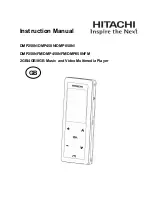
Using the Command and Response Table
Symbols (parameters), defined below, are used throughout the
Command and Response
Table for MSVPP Commands
, which begins on page 60. The symbols represent variables
in the command/response table fields. Letters in the command field are not case-sensitive.
Hexadecimal equivalent are not necessary for the MSVPP command set, with the possible
exception of the carriage return character (
0x0D
) and the line return chararacter (
0x0A
).
Symbol Definitions
]
= CR/LF (carriage return/line feed)
}
= Carriage return (no line feed)
•
= Space (hard) character
X!
= Folder name
Name of a DCP folder (such as “720p_422_60_donkey“)
X@
= Clip name
Name of a clip file (such as “rafting_720p_5994.cpl.xml“)
X#
= Output (channel)
1 = channel 1
2 = channel 2
1,2 = both channels
X$
= Playlist name
Name of a playlist file (such as “Canyon documentary.espl.xml”)
NOTE:
For the clip name (
X@
) and playlist name (
X$
), the name that you enter
must
include the file extension (“cpl.xml” for a clip or
“espl.xml” for a playlist) to be valid. If you try to enter a name without the file extension, the media player responds with
ERROR
.
X%
= Playlist position
Sequential postion of a clip in a playlist
X^
= Play speed
Speed at which to play video, where:
1.0 is normal speed, 2.0 is 2x normal speed, and so on
A positive value (+) is forward video (+ is assumed if no direction is specified)
A negative value (–) is reverse video
Fractional speeds are rounded up or down to the 3rd decimal place (0.000)
X&
= Frame count for advance command
Number of video frames to jump forward or backward, where:
A positive value (+) is forward (+ is assumed if no direction is specified)
A negative value (–) is reverse
X*
= Frame count for seek and assorted timecode commands
nn
:
nn
:
nn
:
nn
(“hour”:”minute”:”second”:”frame”)
X(
= Property name
“PlayAt“, “StartTime“, “StopTime“, or “TimecodeMode”
NOTE:
All names, file names, clip names, and property names,
are
case sensitive.
X1)
= Playlist property value
If
X(
= “TimecodeMode“
:
X1)
= “Disabled“, “Generate“, or “Receive”
If
X(
= “PlayAt“, “StartTime“,
or “StopTime“
:
X1)
=
nn
:
nn
:
nn
:
nn
(hours:minutes:seconds:frame)
If
X(
= “Path“
:
X1)
= the path to the playlist file (an empty character if the file is in the
root playlist folder)
X1!
= Timecode mode
“timecodeGenerate“ or “timecodeReceive”
X1@
= Timecode receive mode setting
“chase“ or “trigger”
X1#
= On/off (audio mute, loop, input trigger)
0 = off or 1 = on
X1$
= Video mode
“1_channel”, “2_channel”, or “2_channel_locked”
X1%
= Video output
video.hdsdi = HD-SDI output video (channel 1
and
channel 2)
ch1.video.dac = channel 1 analog video
ch1.video.dvi = channel 1 digital video
ch2.video.dac = channel 2 analog video
ch2.video.dvi = channel 2 digital video
X1^
= Colorspace
“rgb” or “yprpb•bt.709”
X1&
= Color value
000 (none) through 255 (maximum)
X1*
= Alpha blend
000 through 255
X1(
= Time
0.00 (seconds) though 255.0
X2)
= Genlock mode
“master“, “esgen“, “esgenlegacy“, “blackburst_ntsc“, “blackburst_pal“,
or“trisynch“
NOTE:
“esgen“ is sync slaved to the proprietary Electrosonic ESGen
sync.
“esgen_legacy“ is sync slaved to the proprietary Electrosonic ESGen sync (native to older products, such as the MS9200).
“master“ is ESGEN sync output as a master.
“trisynch” is HDTV tri-level sync.
JMP 9600 Media Player • Programming Guide
58
















































